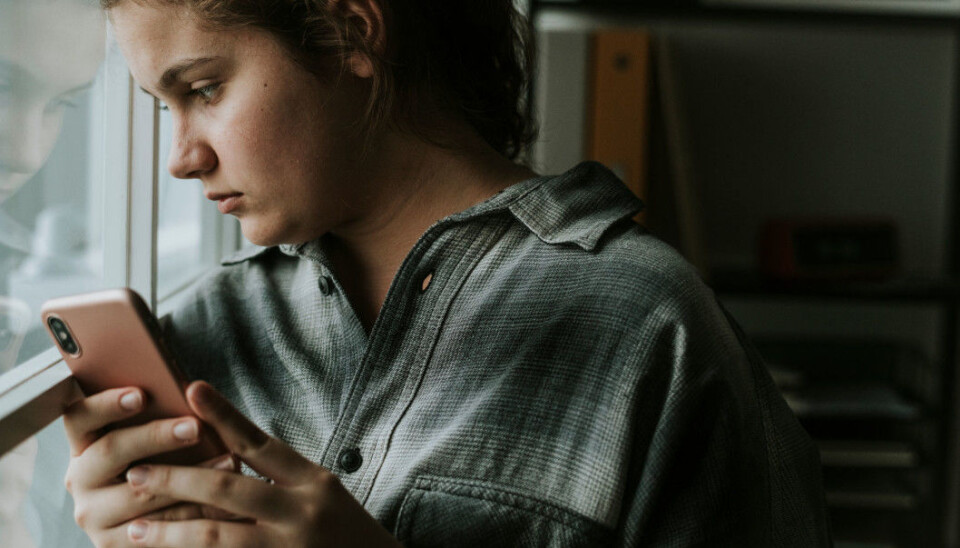
Online bullying can cause post-traumatic stress-like symptoms
Many children and young adults have their mobile phones with them when they go to sleep. Some find it absolutely necessary. They never know when they will get a message from a bully.
When you’re a kid who gets bullied, Sunday is the worst.
That’s when children who are subject to serious online bullying have to figure out how to convince their parents that they should be allowed to stay home from school on Monday.
“One of the main strategies for a child who is being bullied is to avoid school. Research has shown a connection between bullying and refusing to go to school,” says Ida Risanger Sjursø, a PhD candidate at the University of Stavanger’s Learning Environment Centre.
Fear, apprehension and anxiety attacks
Sjursø has previously found that children who experience digital bullying are more fearful, apprehensive and subject to anxiety attacks than victims of traditional bullying.

Now she has looked at what happens to children who experience bullying online for a long time. She and her colleagues have interviewed young people in Norway and in Ireland who have been subjected to digital and traditional bullying over a period of between one and seven years.
“We found that some of the symptoms they described resemble post-traumatic stress. It shows how serious this is and how much it affects children and young people,” she said.
There is often a large overlap between being bullied online and experiencing traditional bullying. About half of those who are bullied are subject to both types. This is a particularly vulnerable group in relation to the development of emotional problems, the researcher believes.
Bullying has many faces
Online bullying is very different depending on how old the children are.

From the age of seven to eight, children who are bullied can have difficult experiences related to the use of digital media.
For the very young, this takes the form of being shut out of games, says Sjursø. Games are an important part of everyday life for children and not being able to play online can be tough for a seven-year-old.
When children get older, bullying becomes more advanced and has more to do with offensive words in texts or on social media.
For both the youngest and the elderly, it can also involve sharing hurtful images or theft of passwords, for example.
Bullying messages around the clock
Researchers don’t really know why digital bullying provokes more anxiety than traditional bullying.
Sjursø believes one factor is accessibility.
“Children and young people bring their mobile phones with them everywhere, and they take them with them when they go to sleep. It’s a necessary evil for some kids because they can have negative experiences as a result. Having a mobile phone available 24 hours a day and knowing that at any time something negative can show up can cause children to become quite anxious,” she said.
So can comments or photos that are widely published and shared.
“A child who experiences traditional bullying has a little more control over the situation. They know who was there when it happened. But if someone puts out a negative comment or a picture of you online, you have no control over how many people have seen it,” Sjursø said.
Often happens anonymously
A great deal of digital bullying is anonymous. The person who is being harassed may know the bully, but often does not know his or her actual identity. The bully often has an anonymous profile, a hidden mobile number or pretends to be someone else.
One of the latest apps that has become popular among young people is the anonymous chat app Tellonym, which some people have called a "bullying app”.
Previous research shows that students who have parents who are not interested in their child's digital life are at greater risk of being exposed to digital bullying. They also have a greater risk of being digital bullies themselves.
"Parents have to acknowledge that they can’t keep up with everything — but just showing interest and talking to their kids about what is happening online can be quite preventative," she says.
For example, parents should teach their children how to block others and how to report bullying. They should also provide them with tools for improving their ability to respond to negative happenings.
“For example, replying to a bully can have very negative consequences. Then the snowball can start rolling and things can get out of control,” she said.
Online bullying is the biggest challenge
Gréta Björk Guðmundsdóttir is a researcher at the University of Oslo’s Department of Teacher Education and School Research. She is involved in an ongoing European research project that is documenting the development of students' digital expertise. In addition, she teaches students who will become educators.
She believes that teachers find the bullying problem to be the most serious and difficult to deal with and that it challenges their digital expertise.
“Digital bullying can be so invisible. It takes place in areas that teachers and parents can’t access and that students follow around the clock. But regardless of whether digital bullying takes place at school or at home, teachers must be able to handle it. It is very important in creating the learning environment in school. Teachers have to be able to pick up danger signals and take action,” she said.
----------































